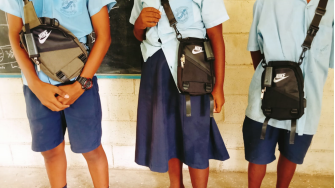Assessing school children’s exposure to air pollution in Solomon Islands
UNSW Humanitarian Engineering Research Grant
UNSW Humanitarian Engineering Research Grant

Humanitarian engineering research addresses school children’s exposure to air pollution in urban and peri-urban areas of Solomon Islands capital Honiara, - in line with the UN Sustainable Development Goals 3 (Good Health and Well-being) and 7 (Affordable and Clean Energy).
Humanitarian engineering research addresses chronic needs of poverty and lack of resources in line with the United Nations Sustainable Development Goals as well as acute needs associated with natural disasters and human displacement. Humanitarian Engineering is a part of every School in the UNSW Engineering Faculty, with real-world research being undertaken to develop appropriate and sustainable solutions to problems for disadvantaged communities.
UNSW Humanitarian Engineering (HE) academic lead Dr Andrew Dansie manages the UNSW HE competitive small grants program. “The program is designed” he says, “to provide some extra support for PhD researchers whose research aim is to foster local partnerships and improve the lives and livelihoods of those in need in low or middle-income countries and Australia.”
Jimmy Hilly was a recipient of a UNSW Humanitarian Engineering grant which supported his study of school children’s exposure to air pollution in the Solomon Island’s capital, Honiara.
Jimmy Hilly is a PhD candidate at the School of Civil and Environmental Engineering who recently submitted his thesis on “Air quality and health risk in the Pacific, Focusing on Fiji and the Solomon Islands” under the supervision of Dr Andrew Dansie. Hilly was also a recipient of the Australian Government’s Research Training Program Scholarship (RTP). His PhD project is part of a broader air quality monitoring program in the Pacific in partnership with Pacific governments and universities.
As part of Jimmy Hilly’s research, air quality monitoring stations have been installed in urban and peri-urban areas of Honiara, Solomon Islands and Suva, Fiji. These stations have been measuring size fractions of airborne particles (PM1, PM2.5, PM4, PM10, and Total Suspended Particles (TSP)) and weather variables (air temperature, humidity, rainfall, air pressure, wind speed and wind direction).
PM2.5 are very small particles usually found in smoke. They have a diameter of 2.5 micrometres (0.0025 mm) or smaller. PM2.5 particles are a common air pollutant. The particles are so small they can get deep into the lungs and into the bloodstream. PM10 is commonly found in dust and smoke, and is particulate matter of a diameter of 10 micrometres (0.01 mm) or smaller. Exposure to these particles can and do affect human health.
To date, the data from the air quality monitoring stations show that the concentration of PM2.5 has exceeded the 2021 World Health Organization Air Quality Guidelines (AQG) of 15µg/m3 for short-term exposure (24 hour) period, in three quarters of the days measured between 2019 and 2023. This is a health concern. Note also that the WHO AQGs 2021 recommend annual mean concentrations of PM2.5 do not exceed 5µg/m3.
The World Health Organization (WHO) estimates that more than 90% of the world’s children breathe air with pollution levels above the WHO guidelines resulting in an estimated annual 600,000 fatalities. Air pollution causes over half of all child deaths from acute lower respiratory infection in children under 5 years in lower to middle income countries.
Children are especially vulnerable to the harmful impacts of air pollution due to their “windows of vulnerability” during the developmental stages of their organ systems including their immune system and lung function as they undergo critical development.
Children in the Solomon Islands are experiencing a high disease burden of lower respiratory infection (LRI) with an incidence of 774 cases per 1000 children under five years. Almost half of all LRI cases in children can be attributed to household air pollution (HAP).
The study focusing on school children was part of Jimmy’s PhD research conducted in urban and peri-urban Honiara, the capital city of the Solomon Islands (Figure 1), with the assistance of UNSW Honours Student Franco Robleto Prego. Ethics approvals from both UNSW and the Solomon Islands were granted for this study.
While ambient (outdoor) air quality is an important factor to personal exposure, indoor air quality is equally important because this is where people spend a substantial amount of their time. The aim of this study was to measure the personal exposure to PM2.5 in microenvironments in both urban and peri urban settings in Honiara.
Flow 2 personal air quality monitors were used on school children to measure the concentration of PM2.5 and PM10 over a period of 24 hours per student. Household surveys were conducted to determine environmental health factors at home.
While average concentrations of PM2.5 were below the 2021 WHO AQG, the concentration peaked between 10:00 and 12:00 hours (at school) (4.84µg/m3 (urban), 6.32 µg/m3 (peri-urban)). and again at 14:00 hours (commuting home.) (6 µg/m3 (urban), 4 µg/m3 (peri-urban)). The highest peak was in the evening between 17:00 and 19:00 hours (at home) (8.35 µg/m3 (urban), 8.91 µg/m3 (peri-urban)).
In a typical week, students spend most of their time at home at an average of 14-16 hours per day followed by school at an average of 7 hours. They spend the least times commuting to and from school and in other environments such as shops and recreation. The highest exposure was at home where they spend most of their time, followed by the classroom.
Common activities at home contributing to poor air quality includes burning of waste, using firewood for cooking which usually occurs in the evenings. Additionally, the use of mosquito coils impacts air quality, as well as proximity of homes to roads, and other commercial activities.
This data will be presented to the Solomon Islands government for action.
Recommendations include but are not limited to: